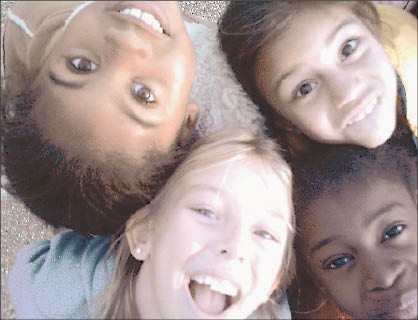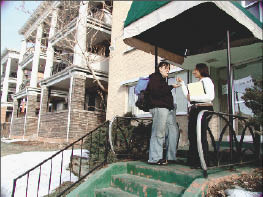For people writing grant proposals on behalf of youth-serving nonprofits, few applications can look as daunting as those for the federal Community Development Block Grant (CDBG). An organization that provides court-appointed child advocates in Houston says its application totaled 116 pages.
But for many groups, the payoff is well worth it: CDBG money recently added a wing to a youth shelter in Denver, brought mentoring and life-skills programming to schools in Grand Rapids, Mich., and provided job training and placement for Native American youth in Portland, Ore.
The grants served more than 1 million youth in fiscal 2006, according to the U.S. Department of Housing and Urban Development (HUD), which runs the 34-year-old program. HUD provides block grants to states and municipalities, which use the money to fund local projects.
 |
|
Reason to smile: CDBGs fund health, education, employment, recreation and substance abuse prevention programs for youths like these in Grand Rapids, Mich.
Photo: Grand Rapids Dept. of Parks and Recreation. |
“It is a large and relatively flexible funding source,” says Roxana Torrico, senior program associate at the Washington-based Finance Project and author of the report, “Using CDBG to Support Community-Based Youth Programs,” published in January. “It is a substantial amount of funding to states and communities to service youth of low and moderate income.”
“It’s one of the most widely accessed sources for youth programs,” says Phillip Lovell, vice president for education policy at Washington-based First Focus. “It’s not enough for a full program, but any little bit counts.”
That despite the fact that CDBG funding has been shrinking for years; the program was funded at $3.7 billion in 2006, down 10 percent from the previous year. Seventy percent of the 2006 money went to cities and urban counties and 30 percent to states.
Federal law stipulates that the funds be aimed at low- to moderate-income people and help prevent or eliminate blight or address other urgent community needs.
While only 15 percent of CDBG funds in a given jurisdiction can be used to provide services – perhaps the most obvious reason for a youth-serving agency to fill out a Request for Proposals (RFP) – agencies can also use the money for capital needs, which is the CDBG’s primary focus. The program also funds economic development initiatives, like micro-enterprise assistance, that can be geared toward youth populations.
CDBG hopefuls need to familiarize themselves with HUD’s regulations and how the RFP process works in their local areas, according to Torrico’s report. It says youth-serving agencies should:
• Find out whether their jurisdiction gets CDBG funding.
• Ask the administering office – usually a state or county community or economic development office – for the five-year consolidated plan and the annual action plan.
• Determine how their program’s goals and priorities align with what’s laid out in those plans.
• Choose projects or activities to seek funding for, including existing projects.
• Identify key players and develop relationships. Those could include government community and economic development officials; members of committees that make funding decisions, which consist of state legislators for state-administered money or local council members in cities and counties; community advocates who know the history and politics; and other service providers, especially those who already receive CDBG funds.
“It is important for program leaders to look to their community to see how [the money] is allocated, and to try to understand that process,” Torrico says. “If youth programs aren’t currently a priority, how is it that they can advocate or try to influence community priorities so that youth are at the top of that list? … There’s definitely going to be a need for research and relationship-building during that process.”
A final challenge is filling out the paperwork, says Melissa Treadway, grants manager for Child Advocates Inc., a court-appointed special advocate (CASA) agency in Houston that receives CDBG money. “You have to have five copies, everything signed in blue ink,” she says. “It has to be tabbed. It has to be submitted by 2 p.m. on a certain day. It’s not online – everything needs to be mailed in. It’s gotten to be kind of comical.”
Under the CDBG’s programs and services category, funds can be used for services in health, welfare, education, employment, recreation and substance abuse prevention. The Finance Project report notes that in a community that’s not already spending the maximum 15 percent of its allotment for programs and services, youth programs will have an easier time gaining funding, because they won’t have to compete with current grantees.
Capital projects might have an easier time gaining CDBG funding because there is no restriction on how much a jurisdiction can allot to them, the report says. But CDBG funds in and of themselves seldom provide enough to finance such projects.
A third category of possible funding can be targeted to older youth with an entrepreneurial bent, the report says. Funds under this Microenterprise Assistance stream can be used for technical assistance to help youths start businesses, or as matching funds for individual development account (IDA) programs, which can pay for education or job training, buy a home or start a business. Youths also can receive employment, training and support services in businesses already funded through CDBG.
“It’s a funding stream that will definitely be here to stay, and it’s a huge priority for the mayors,” Lovell says. “But kids aren’t always at the top of the priority list as the HUD offices are giving out those funds.”
The recent report is available at http://www.financeproject.org/publications/CDBGyouthprograms.pdf.
Following are example of how youth-serving agencies have used CDBGs.
Child Advocates Inc.
Houston
(713) 529-1396
http://www.childadvocates.org
 |
|
Getting ready: A child and her CASA volunteer shop at a back-to-school event.
Photo: Child Advocates. |
Approach: Like all Court Appointed Special Advocate (CASA) agencies, Child Advocates uses court-appointed volunteers to help judges make decisions in child abuse and neglect cases. But unlike most of those agencies, it has been getting CDBG grants for “at least 20 years,” according to Grants Manager Melissa Treadway.
Child Advocates finds out about CDBG funding opportunities when Harris County sends RFP alerts to local grant-seeking agencies, telling them where to look for new applications, along with dates for training sessions to help agencies understand the applications.
It’s not easy. Treadway says one of its applications was 116 pages. “They’ve got a lot of attachments,” she says. “It’s still sort of confusing, only because there are so many attachments, and it’s quite particular. It’s kind of a city thing; they have a lot of rules they need to follow.”
The application needs to show that the agency is serving children at the appropriate income level and meet other criteria, and it lays out the percentage of salary and benefits for the advocacy coordinator and other employees as well as the hours they put in on cases, Treadway says.
History: Child Advocates began 24 years ago as part of the national CASA network. Three women founded the agency at one of their homes and served 18 children the first year, says Marketing Manager Dena Miller.
Youth Served: The program served 1,705 youth in 2007, mainly through referrals from the courts and Child Protective Services. The Harris County program is the largest in Texas.
Staff: The agency has 40 employees, most of whom provide support services to court-appointed volunteers. Child Advocates had 534 of those volunteers active in 2007, Miller says.
Funding: Child Advocates had a budget of $2.9 million in fiscal 2007 and hopes to reach $3.2 million in 2008, Miller says. The program received $74,760 in CDBG funding last year from the Harris County Community and Economic Development Department. The money came under the 15 percent set-aside for services and programming, and partially supports the salaries of about 20 advocacy coordinators. Each coordinator supervises about 24 volunteers and serves 170 children.
Indicators of Success: Miller says the primary indicator of success is the number of children served. A study that Child Advocates conducted with the University of Houston from 1998 to 2005 found several positive results for children with court-appointed advocates in Harris County. The study showed they reached permanent placements more quickly, received a greater degree of medical and psychological services, and scored higher on such attributes as sense of acceptance, controls against deviant behavior, positive attitude toward the future, placing a value on achievement and ability to work with others.
Urban Peak
Denver and Colorado Springs, Colo.
(303) 974-2900
 |
|
Gimme shelter: Urban Peak provides homeless youth with myriad support and placement services.
Photo: Urban Peak. |
http://www.urbanpeak.org
Approach: Urban Peak runs two youth shelters (one in Denver and one in Colorado Springs) that house a total of 40 youths, plus an overflow capacity of 10 for particularly high-demand days, says CEO Kay Ramachandran. Its services include GED preparation, crisis counseling, a computer lab, arts activities and storage for the belongings of the youths in the shelters. Partners like the Colorado Coalition for the Homeless and the Mile High Council provide other services, such as mental health and substance abuse counseling.
Urban Peak ultimately aims to help youth stay off the streets permanently through family reunification, foster placement or independent living.
The organization received $200,000 in CDBG funding from Denver’s Office of Economic Development, Housing and Neighborhood Development to add 1,150 square feet of space inside its main shelter in Denver, which will be used for programming, meetings and general living space. The grant also funded 500 square feet of covered outdoor space. The expansion, which is under way, will enable the shelter to serve 150 more youths through daytime services. The shelter is not licensed to add beds.
Having arrived as CEO in late 2007, Ramachandran did not play a role in convincing the city to provide the CDBG, but says: “They understand Urban Peak’s issues so well, I don’t think it was a huge hurdle.”
History: Urban Peak is 20 years old, and the shelter is 10 years old, Ramachandran says.
Youth Served: In 2006, the program served 800 different youths, ages 14 to 24, including 450 through the shelter.
Staff: Ramachandran says the organization has about 100 staffers, who range from formerly homeless youth with the “passion” to come back and work there, to social workers, therapists and “professional nonprofit people like myself.” The Denver office has 72 employees, 20 of them at the shelter.
Funding: The organization’s annual budget is $4.5 million, of which $1.5 million funds the shelter. The largest appropriations come from the city Department of Human Services and from private donors; Urban Peak also receives federal, county and foundation allotments. The $200,000 from CDBG comes via the capital funding stream within that program.
Indicators of Success: Urban Peak tracks those who leave the shelters, and estimates that 50 percent to 60 percent become independent through some combination of housing and employment, attending college, and reuniting with their families.
Recreation Reaps Rewards
Grand Rapids, Mich.
(616) 456-4222
http://grcity.us/parksandrecreation
 |
|
Reaping rewards: Points earned for achievement, service and behavior keep Grand Rapids’ youth smiling.
Photo: Grand Rapids Dept. of Parks and Recreation. |
Approach: Recreation Reaps Rewards provides exercise and academic support with certified teachers and tutors, snacks after school, lunch in the summer, and life-skills training, says Larry Barnes, a recreation services specialist with the Grand Rapids Parks and Recreation Department.
Barnes built the program over the past 16 years, saying it evolved as he saw a need for more “than just recreation. We started looking to address some of those other needs: Kids who are struggling academically, their parents either working hard and not there to provide life skills, or struggling with personal issues themselves. … We’ve been working hard to make it comprehensive.”
For the life-skills component, he says, the program brings in such groups as the Boy Scouts and Girl Scouts, the local children’s museum, ballet and sports teams, and the Michigan State University Extension. The program is free; participants earn rewards through academic achievement, attendance, community service projects, attitude and behavior, all calculated with a point system.
The program initially focused on African-American communities, but has spread across the city, Barnes says. “If a school is failing in math, we’ve been able to tailor services to meet that need,” he says. “I’m glad to have been able to be responsive to the needs of the clientele, as opposed to saying, ‘Here’s what we have. You can avail yourselves of it, or not.’ ”
CDBG funds are targeted to low-income, high-crime areas. The program reapplies annually, and “we’ve been fortunate enough to have a very good track record,” Barnes says.
But as with CDBG applications around the country, getting the money is not a shoe-in. “As the [federal] administration has changed, the pot has gotten smaller and larger” at different times, Barnes notes. “Our community development department here sometimes has had different philosophies, [or] wanted to fund new organizations, which has led to changes in allocations. …
“We’ve had to have the community, at times, come in to city commission meetings and advocate for the funds and make sure they’re available.”
History: Recreation Reaps Rewards began in 1992 “in areas where residents were not using mainstream recreational services, either because they were the wrong services or were in locations where people did not feel comfortable,” Barnes says.
Youth Served: About 5,000 youth from grades K through 12 are enrolled at 20 sites. “We don’t turn anybody away,” Barnes says, although several funding sources have target populations.
Staff: The program has about seven full-time employees and 100 to 150 part-timers at various locations, Barnes says.
Funding: The annual budget for Recreation Reaps Rewards is more than $1.5 million, nearly 10 percent of which ($136,162) comes from the 15 percent set-aside for programming within CDBG – which was its first funding source, Barnes says. Other funding streams include the city government and the federal 21st Century Community Learning Centers (CLC) program.
“It’s helpful that we have other funding sources kicking into the pot,” Barnes says. “We’re able to report to CDBG that they’re getting a lot of bang for the small amount of money they’re putting in.”
Indicators of Success: The CDBG and the CLC require before-and-after evaluations of children who participate, which are totaled by location and compared with the past progress of each one, Barnes says. But he says the data, tallied by researchers at Michigan State University, is not totaled or evaluated citywide.
Portland Economic Opportunity Initiative
(503) 823-2385
http://www.portlandonline.com/bhcd/index.cfm?c=30143
Native American Youth Employment Services
Portland, Ore.
(503) 288-8177
http://www.nayapdx.org
The Approach: The Portland Economic Opportunity Initiative is a city-run poverty-reduction effort that includes work force and micro-enterprise programs. Of the 34 community agencies that participate in the initiative, 13 target youth.
Services include free bank accounts and credit repair, individual development accounts (IDAs) at a 3:1 match, and legal help for anything from getting a driver’s license reinstated to getting a prior conviction expunged, all with an eye toward employability.
CDBG money funds about 60 percent of the initiative, says Program Director Lynn Knox. “They pay for all of the city staff time to manage and then hustle and create support services” for the community agencies, she says. “They’re having a problem in their organization, and need to hold a retreat and work out some new program elements, and get training – all that comes from CDBG.”
One of the 13 youth-oriented programs, Native American Youth Employment Services (NAYES), part of the Native American Youth and Family Center, serves the 31,000 Native Americans in Portland. Half of them live at less than 200 percent of the federal poverty level, says Executive Director Nichole Maher.
Although the unemployment rate among Portland’s Native Americans exceeds that of the general population, Maher says, they generally mistrust government and other “majority culture organizations,” making them hesitant to access many employment-related services.
“We said, ‘Let’s be honest about our population. If our people were easy to serve, someone already would have,’ ” says Maher, a member of the Tlingit tribe.
The program provides “culturally competent” services by hiring and recruiting Native staff, aggressively addressing such issues as criminal records or alcoholism, and providing a program consistent with their population’s capitalism-ambivalent world view, Maher says. She says the agency stresses benefits to family and community rather than just the individual, and includes a community service training component.
NAYES failed to receive CDBG funding on its first attempt, but worked with Knox and her staff to find common ground, Maher says. “They didn’t understand how large our community is and how diverse, and what the challenges are in terms of employment,” she says. “I don’t really think they understood the fear-of-government piece.”
As for her agency, though, she adds, “I don’t think we demonstrated enough strong partnerships with employers, and we didn’t understand the importance of having that ahead of time.”
“We worked with them to identify the strengths and weaknesses of the proposal,” Knox says. “There’s a lot of mutual education along the way.”
History: The Portland Economic Opportunity Initiative funded its first 19 projects in fall 2004, about eight of which were youth-oriented, Knox says. The Native American Youth and Family Center was founded in 1974 as an all-volunteer organization and incorporated as a 501(c)(3) in 1992. It launched NAYES in 2001 and has received CDBG funding through the city for three years.
Youth Served: Portland’s initiative supports slightly more than 2,000 young people, mostly ages 18 and older, “at a stage where they are devoting most of their time to earning an income or preparing to earn an income,” Knox says. Youths are all targeted by partner agencies.
Last year NAYES served 300 people, including 117 youth (ages 17 to 26), Maher says.
Staff: The city provides two full-time staffers (including Knox) and three part-timers to run the initiative, while the total staff at all 34 participating agencies is more than 100. The city holds regular meetings for group training, problem-solving, and sharing of resources and ideas.
NAYES has four employees; the Native American center has 59 overall, plus nine VISTA volunteers. Most of the staffers dealing with employment services are Native American, Maher says, “folks who have standing and are acknowledged and respected in the community, but also folks who have technical training and skills to do either case management or employment placement.
“Finding folks who have that combination of skill sets is very difficult.”
Funding: The initiative receives about $14 million in CDBGs, which covers about 60 percent of its budget. It also draws from general city funds and some private resources, Knox says.
NAYES’ annual budget is $6 million. It spends about $450,000 a year on employment services, and last year received $184,444 from CDBGs for that purpose, under the youth employment and micro-enterprise funding stream.
Doing employment services “would be really difficult” without CDBG funds, Maher says. “The CDBG funding for our employment programs supports core employment activities, and it’s a real leveraging opportunity.”
Indicators of Success: The Economic Opportunity Initiative’s goal is to increase participants’ income and access by at least 25 percent within three years. It reports that by December 2006, two years into the program, 66 percent of its 1,865 participants had satisfied that goal. By the end of 2007, those employed at the outset had doubled their wages, while those unemployed in 2004 had increased their wages by one-third since initially being placed. In addition, the Northwest Area Foundation has funded replications of the initiative in several Minnesota cities.





























